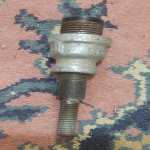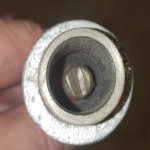You are using an out of date browser. It may not display this or other websites correctly.
You should upgrade or use an alternative browser.
You should upgrade or use an alternative browser.
Annealing brass in molten lead
- Thread starter kjohn
- Start date
vagrantviking
CGN Ultra frequent flyer
- Location
- Southern Alberta
I've tried it but probably won't again.
If you cast or know anything about molten metal or salt you know about the hazard of water getting into the mix. Also bad is trapped air. Make sure primers are out. Even sizing lube residue can sizzle and spatter.
It's great that you can control the temperature very well if you have a thermometer or pid controller but it's much tougher if you don't.
My problem was lead soldering itself to the cases. Maybe there's ways to prevent it but I was annoyed enough I didn't peruse it.
I've done lots with a torch in a dark room but next time I plan on trying sandblasting glass bead or sand in a small Lee 5lb pot with a thermometer and maybe a lid with holes if it helps stabilize the temperature.
Not sure if heat transfer will be fast enough to get the end to temperature before it migrates too far to the base but I'm thinking this is a pretty low hazard thing to experiment with
If you cast or know anything about molten metal or salt you know about the hazard of water getting into the mix. Also bad is trapped air. Make sure primers are out. Even sizing lube residue can sizzle and spatter.
It's great that you can control the temperature very well if you have a thermometer or pid controller but it's much tougher if you don't.
My problem was lead soldering itself to the cases. Maybe there's ways to prevent it but I was annoyed enough I didn't peruse it.
I've done lots with a torch in a dark room but next time I plan on trying sandblasting glass bead or sand in a small Lee 5lb pot with a thermometer and maybe a lid with holes if it helps stabilize the temperature.
Not sure if heat transfer will be fast enough to get the end to temperature before it migrates too far to the base but I'm thinking this is a pretty low hazard thing to experiment with
- Location
- Western Manitoba
Was apparently an old school - like 1940's - way to get an object to a known temperature - soak it in a heated liquid - molten lead, melted salt or various combos of salts, etc. Always a balancing act to use stuff that does not get so hot to produce toxic vapours - like lead will, if you get it too hot. Then, I read much variation in what it takes to actually "anneal" that brass - so 5 seconds at 400 C? 2 minutes at 300 C? a tenth of a second at 2,200 degrees F? Was much that I read on various chat rooms where it appeared some posters were confusing a Celcius (Centigrade) number with a Fahrenheit number - can be same temperature, but vastly different number - depending what temp scale that one is using. I am no longer sure about what is correct number and amount of time, but I am sure there is one or more combo of both that will restore "hardened" brass to a more pliable state. Even that is hard to measure - did it actually accomplish what you thought it did? - is multiple sources that state that the oxidation colours on the brass are NOT a sign that "annealing" has occurred, but merely a sign that the brass has been heated - so must be some sort of hardness tester needed to know / prove that the brass is softer and more pliable after the process than before. I recently did about 100 or so elderly R-P brass - previously fired, probably multiple times - I thought that I followed the instructions closely - but got 7 split necks when I re-sized those brass after I thought that I had "annealed" them.
Last edited:
vagrantviking
CGN Ultra frequent flyer
- Location
- Southern Alberta
I can usually feel a difference when sizing after annealing. Some cases will have less springback and therefore better neck tension on the bullets.
Most of the cases I do are for low pressure bp cartridges so I can probably get away with softening the brass a little more than someone doing hot wildcats or similar.
Most of the cases I do are for low pressure bp cartridges so I can probably get away with softening the brass a little more than someone doing hot wildcats or similar.
It works well if the primers are removed and the brass is dirty. Not dirty dirty but once fired dirty so the lead doesn't bond. Lead likely wouldn't bond to clean brass anyway as you need flux to make it happen. I've been using salt and it works well but you have to wash and dry the cases when done to get rid of the corrosive salt. Its a ballistic recreations set up
I use the socket and propane torch method. Fit a deep socket to the case, probably 1/2", with an extension. Propane on with just over 1" long flame. Rotate neck of case slowly in propane flame until the discoloration runs down the shoulder, approx 6-8 seconds. I trashed a couple pieces the first couple times I started annealing to see where the threshold of beyond recoverable was. When they start deforming easily, you've gone to long. Pretty simple and works for multiple cartridges. Very clean and safe comparatively.
Last edited:
vagrantviking
CGN Ultra frequent flyer
- Location
- Southern Alberta
It works well if the primers are removed and the brass is dirty. Not dirty dirty but once fired dirty so the lead doesn't bond. Lead likely wouldn't bond to clean brass anyway as you need flux to make it happen....
Dirty is definitely better but even on black powder dirty cases some lead would stick in spots of varying size. Lots would come off with a fingernail but some I basically had to scrub off with steel wool.
Maybe not a big deal if you don't mind tossing some. Powdered graphite or similar might solve the issue but I didn't take it that far.
vagrantviking
CGN Ultra frequent flyer
- Location
- Southern Alberta
Maybe give it a shot with some cases you don't mind tossing if you have the equipment. I only tried what I thought up at the time and may have missed something obvious.
It could be a good way to control temperature and not buy expensive new gadgets. I will try the lead pot full of sand type thing one of these days too.
It could be a good way to control temperature and not buy expensive new gadgets. I will try the lead pot full of sand type thing one of these days too.
BattleRife
CGN Ultra frequent flyer
- Location
- of No Fixed Address
The average reloader has very little understanding of what annealing does, how it does it, or what parameters are required to make it work.
Annealing in lead should do the job just fine, the only drawback is the likelihood of lead sticking to the brass. But what difference does it make if the user has no idea how to employ the process or measure the outcome?
Annealing in lead should do the job just fine, the only drawback is the likelihood of lead sticking to the brass. But what difference does it make if the user has no idea how to employ the process or measure the outcome?
I used the salt bath for a while. Worked great. Kit come with a thermometer so temp control is accurate as the lee small pot can hold. A kit cost about $130 + lee small casting pot.
Would not even thing about trying in my casting pot…
Would not even thing about trying in my casting pot…
Tried it and walked away.
I've been annealing about 20 years and use a propane torch and this gizmo made from plumbing pieces in a cordless drill. The pipe in the centre can be adjusted up and down within the pipe that holds a variety of empty cases and shields the lower half. I've heard that it can't and won't work, but it's just fine.
After a few mistakes, you learn the distance to hold, time and colour. I have Tempilaq and no longer need to use it.


I've been annealing about 20 years and use a propane torch and this gizmo made from plumbing pieces in a cordless drill. The pipe in the centre can be adjusted up and down within the pipe that holds a variety of empty cases and shields the lower half. I've heard that it can't and won't work, but it's just fine.
After a few mistakes, you learn the distance to hold, time and colour. I have Tempilaq and no longer need to use it.










































































